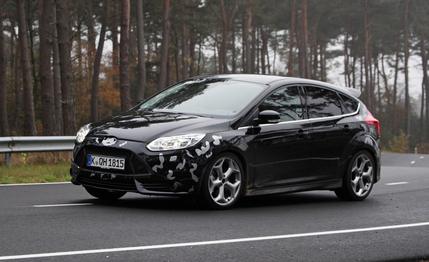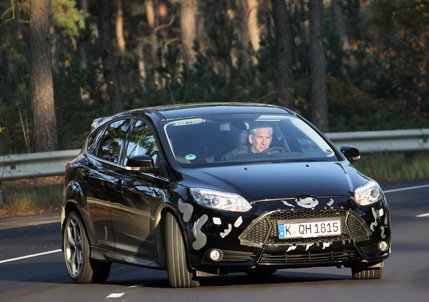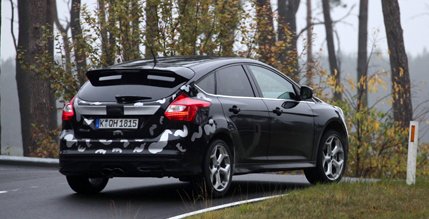
 First Ride
First Ride


“You see how you can play with the back end going on or off the throttle?” asks Jost Capito, who is clearly having fun. Inside Ford’s European proving ground near Lommel, Belgium, the director of Global Performance Vehicles is drifting through the corners of the handling track in his latest project, the Focus ST, adjusting the car’s angle of attack with the right pedal. We notice that when Capito gets back on the gas, the rear of the car comes back into line. In most front-wheel-drive cars, this move would provoke understeer. But the Focus ST is unlike most front-wheel-drive cars.
The Focus ST is also a work in progress. Ford invited us to Belgium to witness the late stages of the car’s development. What’s left to do at this point is the fine tuning, the detail work that separates a great car from one that’s merely good. Under the hood lies Ford’s direct-injected, 2.0-liter turbocharged four-cylinder, bookended by redesigned intake and exhaust systems. U.S.-market output figures have not been announced—it doesn’t go on sale here until late 2012—but the engine makes 247 horsepower and 266 pound-feet of torque in Europe.
Rest assured, our figures will be close. According to Capito, every car in every region will be the same, with the same engine, the same suspension, same tires, same brakes. This is a departure from standard Ford protocol, but Capito has a knack for navigating around the bureaucracies that are typical of large companies. If his name sounds familiar, it’s because this German has as much motorsports experience as a Schumacher: He ran Red Bull Sauber’s F1 campaign from 1998 to 2001. Before that, he headed Porsche’s racing efforts. And before that, he won the truck category in the 1985 Paris–Dakar rally. A story that speaks to his racer’s ingenuity: In the previous Focus ST (an offshoot of the not-for-the-U.S. second-generation Focus), he wanted higher-quality top-grain leather for the steering wheel, but internal regulations forbade this, even for a specialty car. Learning that perforated leather requires the use of the better cowhide, Capito made a new request for perforated leather that circuitously granted him his steering wheel.


The new ST’s tiller will be very close to that of the old car’s, says Capito. “I like a simple steering wheel. It’s something I have to keep the designers away from.” The wheel is connected to a variable-ratio rack that is slower in the middle and quicker on the ends. (Common to Porsches, this is the only such application in Ford’s current lineup.) In between is electric power assist, which is the heart of the car’s torque-steer-compensation system. When the system senses an imbalance of torque to the front wheels, it reduces the steering assist in the direction the steering wheel would normally be yanked. The result, we’re told, is similar to that of the RevoKnuckle strut from the previous Focus RS (a 300-hp Focus also never seen stateside) but without the extra cost and weight of the advanced strut design.
The Global Performance Vehicle division’s mission dictates that every vehicle, including the Focus ST, must be profitable. So changes from the regular Focus are applied economically. The 12.6-inch front brake rotors, 1.7 inches larger in diameter, are gripped by new calipers, but the front suspension is largely unchanged with the exception of spring and damper tuning. At the rear, the main revision is how the ends of the anti-roll bar attach to the suspension. Instead of the standard Focus’s connection to the lower suspension links inboard of the coil springs, the ST links the bar directly to redesigned knuckles. The outboard connections improve the anti-roll bar’s effectiveness because the outer ends of the bar move more in concert with wheel motion.
The only major interior change is the availability of Recaro seats, which offer excellent torso and shoulder support but are still easy to enter. The Focus ST comes with an Active Sound Symposer system under its hood to pipe engine noise into the cabin. The “active” part involves a butterfly valve to control the noise level so that the engine is barely audible in sixth-gear highway cruising, then becomes louder when you get on the gas.


In the interest of economies of scale, the intercooler is from the Ford parts bin, as are the automatic grille shutters found on the fuel-sipping Focus SFE. In the ST, the shutters help turbo cooling at high speeds. The Focus ST uses the same brake-based electronic Torque Vectoring Control (eTVC) found on lesser Focuses. Purists will see this as an electronic Band-Aid, especially because the system is always active to support high-speed cornering, even with the stability control fully switched off. But as far as we can tell, the system works. It’s what allows Capito to bring the ST in and out of a drift through corners and lets Ford get away with such a tail-happy chassis setup.
On the subject of persistent traction assistance and electromechanical antidotes to torque steer, Capito thinks these are fine on a daily driver like the ST. It wouldn’t be appropriate on a more extreme car like the old RS, which sacrifices comfort for performance. He offers the comparison: “The ST is like a dolphin, and the RS is like a shark.”
So how does this dolphin swim? At this point in its development, quite well. For comparison, Ford has assembled the previous Focus RS, a Renault Mégane RS, and a Volkswagen GTI. All are driven around the high-speed oval, on various re-creations of worldwide roads, and on the handling track. The ST’s true bogey is the 200-hp GTI, which is the bestselling hot hatch in numerous markets and an enthusiast icon.


The more powerful ST should be quicker than the VW—we predict a 6.1-second 0-to-60 time—while returning similar fuel economy. The GTI’s brilliance transcends the numbers; from the passenger’s seat, though, it looks like the Focus ST trumps the VW in most categories. Directional changes feel sharper, and the front end tracks true even under power. Whereas the ST exhibits some playful back-end slip, the rear of the GTI stays planted, which is a less entertaining way to get around a corner. The Focus is comfortable and not just because of the better seats. It’s hushed at high speed and handles bumps with minimal suspension and tire noise; pockmarked road surfaces and high-frequency bumps are filtered out.
And yet Capito’s team isn’t finished. He admits that there’s room for more steering feedback. And that the shifter isn’t quite right yet, as it doesn’t have the solid feel of the previous ST’s. The engine note sounds slightly artificial and lacks any turbo clues. He agrees that the occasional sound of a blowoff-valve release would be appropriate and that he wants more low frequencies coming through the sound tube to give the tone more weight.
But as we said, these are the final touches. Even so, we’re left to guess at a lot, including the Focus ST’s price. Given the constant references to the GTI, we think Ford will try to stab VW in the heart and come in at $25,000—nearly identical to the price of the GTI five-door. If we’ve learned anything from the peek into Ford’s development process, it’s that Capito’s team is fiercely competitive and already on the right track. Until we get a proper drive, we’re left to speculate, but our hunch is that the Focus ST will be a force to be reckoned with.